Choosing the right solder for electronics means knowing its composition, melting point, and flux content to ensure it works well for hobbyists, technicians, and professionals in different tasks. We have covered more about Different Types of Solder in a dedicated guide. Check that out for more info.
Key Factors To Consider
- Type of Flux Core: There are basically two different types of cores. Rosin and acid core. An acid core is mostly used for soldering in plumbing purposes and the Rosin core is for electronics. As you are looking for a solder for electronics, go with a rosin core.
- Diameter: This refers to how thick the Solder’s wire is and thinner the diameter, better for finite electronics jobs. But thicker diameters are preferred for multi-strand wires and larger PCB boards to stick up a bunch of elements together. Your available choices include 0.062 inches (large diameter) to about 0.02 inches (finite diameter).
- Length of the Spool: Solder comes in spools. There is no specific metric to measure but it is just that larger spools may cost a fraction higher but if you are a consistent DIY enthusiast, it is better to buy a larger spool to save a buck or two.
There are a few other factors that you would want to consider before making a final choice. We have included all of them in the Buying Guide section of the article, be sure to check it out as well.
Now without further ado, let us jump in and review some of the Best Solder for Electronics
Best Solders for Electronics
| Solder for Electronics | Diameter | Flux Content | Buy Now |
|---|---|---|---|
| Maiyum Solder Wire | 0.031 inches | 1.8% | Check On Amazon |
| Kester Solder | 0.031 inches | 1.5% | Check On Amazon |
| SONEAK Lead Solder | 0.0236 inches | 1.8% | Check On Amazon |
| Austor Solder Wire | 0.02 inches | 2% | Check On Amazon |
| Canfield Solder | 0.125 inches | N.A | Check On Amazon |
| Mandala Crafts Solder | 0.039 inches | 2% | Check On Amazon |
| TOWOT Solder | 1.0mm | 1.8% | Check On Amazon |
| YI LIN Solder | 0.8mm | 1.8% | Check On Amazon |
| ZSHX Solder | 0.8mm | 2% | Check On Amazon |
| HengTianMei Solder | 0.3mm | 1.8% | Check On Amazon |
Also check –
10 Best Solder for Electronics Reviews
1. Maiyum Solder
First on our list is the Maiyum Tin Lead solder. One of the most economically priced solders on the list, the Maiyum solder is of high quality even though it is not of the local build.
With a Rosin core, the solder wire has a 63/37 ratio with 63% of Tin and 37% of Lead content in it. The flux content of the solder lies at a mere 1.8% and the soldering wire has a diameter of 0.8 mm that amounts to about 0.0315 inches. This is decent enough.
The spool comes with a weight of 50 grams (0.11 lbs.) and easily solders into the PCB boards with a simple 361 °F melting point. The best part is that the solder has a 30 days money-back guarantee on satisfaction which is astonishing for a low priced product.
Pros:
- Cheap and economic pricing
- 63% of Tin and 37% of Lead
- Has a steady and Solid flow
- Rosin Core Solder
- The spool has 50 grams to it
- Comes with a 30-day satisfaction money-back guarantee
- 0.0315 inches diameter
Cons:
- Could have had a bit of a larger spool size
2. Kester Solder
Next on our list is the Kester Solder, a 0.031 inches diameter steel-based solder with very high conductivity. Kester is a very popular brand in the DIY electronics section that even the US military depends to use it.
The Soldering wire has a Tin and Lead composition of 60/40. This means that the build is 60% Tin and 40% Lead.
Also, this solder has incredibly fast-melting Rosin Core Flux. This expertly cleans and preps the surface for wire or other element integration. Great for instant wetting action, the solder works fine on nickel surfaces as well. Coming to the spool, you get a 1 pound spool of solder, which is enough for a year’s worth of minor to mid-level DIY electronics.
Pros:
- Steel based build with a Rosin Core Flux
- Available in packs of 1,2 or solder bundles as well
- Incredibly high rated
- Fast to melt
- Strong adhesion and forms very strong joints
- Shiny after it cools down and non-corrosive in natures
- Mid-level 0.031 inches diameter for small electronic DIYs
Cons:
- Slightly premium-priced
- Supply is much more when pulled. Thus use with caution for not wasting a lot in a single go
3. SONEAK Solder
SONEAK is a premium quality solder that has a composition of 60% Sn (Tin) and 40% Pb (Lead). It also has 2.0% flux blend which ensures long-lasting and highly conductive joint.
It has a melting point of 361°F/183°C which makes the solder flow easily, clean, less smoke and reliable.
This 1.0mm (0.0039-inch) diameter soldering wire is suitable for home improvement, electrical soldering, maintenance of stereo, TV circuit boards, repairing and DIY projects.
Pros:
- High quality rosin core solder
- Shiny soldering point
- 60 Sn / 40 Pb
- Reliable and clean
- Wide range of applications
- Easy to use
Cons:
- Too thin for large element soldering
4. Austor Solder
The AUSTOR soldering wire comes with a standard 60/40 Tin to Lead ratio with 60% being Tin and the remaining 40% being Lead.
Quick to melt and spread, the Solder has a high electrical and thermal conductivity. It has a rosin core and a very high flux content of 1.8%. The Solder has a decent 0.032 inches (0.8mm) diameter.
Coming to the melting point of this solder, it is in the range of 185°C – 190°C (365°F – 374°F).
The best thing about the solder would be its neat packaging. Available in a set of six, the Solder comes in tubes of tiny spools rather than a conventional spool. This way, the spool is easier to store and use as well, making it convenient enough. Each pack comes in a 20-gram packaging.
Pros:
- Has a 60% Tin and 40% Lead ratio
- Rosin core flux
- 1.8% flux content
- 0.032 inches diameter
- Available in 20 grams bottled spools and 6 pack deals
- Low melting point and easier to clean and high conductive joints
Cons:
- Premium ended pricing
5. Canfield Solder
Canfield is a highly rated and premium quality Solder that is specifically built for stained glass soldering but can be used for general purposing as well.
The canfield soldering wire has a composition of 60 Sn /40 Pb with 60% being Tin and 40% being Lead. It has a low melting temperature in the range of 360° – 376°F. It has a diameter of 0.125 inches in diameter which makes it one of the thickest Solder on the list.
The spool size of the solder is high as it comes in 1 lb spool roll. But all in all, it offers superior flow and is best suited for broad DIY electronics and stained glass soldering.
Pros:
- Seamless stained glass soldering
- 60% Tin and 40% Lead
- 360° – 376°F low melting temperature
- 0.125 Inches thick diameter
- Superior flow
- 1 lb. spool roll that’s enough for most projects
- Highly rated and greatly reviewed
Cons:
- The thick spool may not be ideal for micro and minuscule PCB projects
6. Mandala Crafts Solder
Manadala crafts solder wire contains 2% rosin, 60% Tin and 40% Lead that provides clean soldering finish. It comes with fast melting and maximum wetting spread that ensures clean and smooth flow.
The Solder has a low melting point temperature of 376°F. This solder wire is suitable for electric, printed circuit board, electronic, jewelry soldering, stained glass, and other DIY applications.
It has good thermal and electrical conductivity and compatible with most of the equipment and soldering irons.
Pros:
- Good thermal and electrical conductivity
- Low melting temperature point
- Shorter soldering time
- Melts clean and flows smooth
- Easy to work with
- Less slag and smoke
- Suitable for wide range of applications
Cons:
- Nothing much to specify
7. TOWOT Solder
TOWOT Solder Wire is great for everyday soldering jobs. It is reliable and affordable. Made with a Sn60-Pb40 alloy, it makes electrical fixes easy.
Its 1.0mm diameter and 50g weight are perfect for precise work on circuit boards and gadgets. It melts at a low temperature, making it easy to use. Whether you are a DIYer or a pro, this solder wire gives you strong, neat joints every time.
Specifications:
- Sn 60%, Pb 40%
- Flux content 1.8%
- Wire Diameter is 1.0mm
- The spool has 50 grams to it
- Low Melting Point
- Excellent Solder Flow
- Fast Soldering Speed
- After-Sales Guarantee Included
Cons:
- Finish may appear dull and matte, lacking the desired shine.
8. YI LIN Solder
YI LIN Solder Wire is designed for precise performance, ideal for both hobbyists and professionals working on electronic projects.
Its 60/40 Tin Lead Rosin Core Solder Wire offers excellent soldering capabilities, leaving behind minimal residue. With its antioxidation properties, it ensures clean and durable solder points.
This 100g wire, with a 0.8mm diameter, is perfect for intricate electronic repairs, such as fixing cables, circuit boards, and home electronics. Its low melting point guarantees fast and efficient soldering, making it suitable for a wide range of tasks.
Specifications:
- Alloy Composition is Sn %60, Pb 40%
- The spool has 100 grams to it
- Flux Content is 1.8%
- Wire Diameter is 0.8mm
- Antioxidation Properties
- Beautiful, Clean Solder Points
- Fast Welding Speed
- Low Residue After Soldering
- Proposition 65 Warning for California Residents
Cons:
- Core flux may not be sufficient for all soldering tasks, requiring additional flux.
9. ZSHX Solder
If you are looking for a solder that prioritizes safety and efficiency, consider ZSHX Solder. It’s lead-free, making it a great choice for those who care about the environment and their well-being.
This solder wire, with a formula of Sn99-Ag0.3-Cu0.7, offers excellent performance. It melts at a lower temperature of 217°C and has antioxidant properties.
With a diameter of 0.8mm and weighing 50g, it’s perfect for delicate electronic projects like circuit boards and home appliance repairs. Whether you’re a DIY enthusiast or a professional, this solder ensures clean, strong joints without the health risks associated with lead.
Specifications:
- Alloy Composition is Sn %99, Ag 0.3%, Cu 0.7%
- Lower Melting Point is 217°C
- Wire Diameter is 0.8mm
- Flux Content is 2%
- The spool has 50 grams to it
- Lead-Free Composition
- Excellent Solder Flow and Quick Melting
- Minimal Residue
Cons:
- Some users find the wire difficult to handle due to its higher melting point.
10. HengTianMei Solder
The next product is Solder Wire by HengTianMei. It is known for its strength and accuracy. This wire is made for modern electronic repairs. Professionals trust it.
The 63/37 wire has a special alloy mix. This mix makes soldering easier, especially for detailed electronic work.
The wire is 0.3mm thick and weighs 50g. It melts at 183°C, which allows for quick and clean soldering. It is great for small tasks like fixing wires on electronic devices. It creates strong, pure joints that help devices last longer.
Specifications:
- Alloy Ratio is Sn 63%,Pb 37%
- Melting Point is 183°C
- Wire Diameter is 0.3mm
- Flux Content is 1.8%
- The spool has 50 grams to it
- Rosin Core for Better Flow
- Excellent for Fine Electronic Work
Cons:
- Higher temperatures required for melting may not suit all electronic components.
Buying Guide: How To Choose a Good Quality Solder?
A spool of solder might seem like a very generic thing. More of a one size fits all model but serious DIY electronics enthusiasts would understand that Solder comes in various types, sizes and compositions. Solder is not only used for creating conducting joints in Electronics but also in Plumbing as well
In this buying guide, we are going to discuss the different types of Solder available, different compositions and much more.
Types of Solder Available
Basically, solder is available in the forms of wire spools, bars, paste or even pellets. Most of the times, it is available in the form of a wire as basic DIY enthusiasts would associate with it. Sometimes, a soldering paste is also common that is mostly used for SMD soldering.
But on a broader scale, solder is categorized into two types.
- Lead-based solder
- Lead-free solder
The main difference between a lead-based solder and a lead-free solder would be the melting temperature.
Lead-based solder has a relatively low melting temperature and also has a low price point as well. But owing to the healthcare concerns of inhaling lead vapors, people are being encouraged to move to a Lead-free solder. Lead-free solder also gives you high-performance and strong joints with great conductivity. They are also neat but may cost a few cents more than a lead-based solder, nothing uncommon.
How To Choose Solder for Electronics?
As we have mentioned above that Solder is not only associated with electronics, plumbing requirements are different than electronics. We are now going to look at a few factors that you would be considered while choosing solder for Electronics.
Type of Solder
Type of solder refers to how you would want the solder to be. Would it be in a solid format? Paste? Spool of wire? Or Pellets?
Pellets or wire are the most common type and if you are a beginner DIY enthusiast, we would recommend that you go ahead with a spool based wire type of solder. They are easier to handle, have better melting points and form really good conductive joints as well.
Composition
Composition of a solder refers to the constituents of what the solder is made up of. As we discussed just now, depending on your choice of project, you would be going forward with the choice of a lead-based or lead-free Solder. While lead-free solder is a highly preferred one, (owing to the lead-based solder may be harmful), you can go with a mixed one too.
The mixed type of solder will come to a majority of tin percentage in the solder with only a minor percentage of lead in them. Usually, the ratios lie between 60% of tin to 40% of lead but there is a great range of solders that come with 63% of tin to 37% of lead or lesser too. Pick wisely.
The Diameter of the Solder Wire
The solder wire’s diameter would define the detailing of the joint you want, need and would get. Larger the diameter, larger and broader is the joint. If you are looking to have a precise and concise joining to be made (like dealing with delicate and small/microelectronics), you would be going with a very small diameter of 0.002 inches or lower too.
For broader applications like strain glass or maybe even larger PCBs with larger elements, you would be going forward with a larger diameter of about even 0.12 inches too. Generally speaking, you would want either a 0.062 inches or 0.032 inches diameter solder for general purposes.
Flux Type and Flux content
The flux of a solder refers to the central element that servers 3 different purposes
- Oxidation removal: Flux helps to remove any possible oxidizing metal from the surface that you are about to solder to prevent any fragile joint
- Air seal/lock: The flux would help to seal the joint into a strong air seal or an airlock. This is to prevent any air movement that would possibly cause corrosion of the wire/elements or the joints.
- Amalgamation facilitation: Flux would improve the wetting characteristics of the liquid solder and thus facilitates amalgamation.
There are a lot of different types of fluxes that are used in electronics and plumbing but the most common and preferred type of fluxes are rosin and acid core. An acid core is mostly used for plumbing purposes and for electronics, you would be going for a rosin core flux.
Another thing that you would be considering is the flux content also. This would refer to the amount of flux available in the solder. This ranges from about 1% to 2% or even 3% or higher too. Higher the flux, better is the lock but for minuscule joints, lower flux percentage is preferred.
Flux would also influence the amount of smoke that would be generated when you are soldering joints. Pine based flux would probably be preferred by a few whereas a few would actually want to go with non-rosin flux as well.
Size of the spool
Size of the spool refers to the amount of pool you would be getting per unit of purchase. While most of the spools come in terms of 50 grams or 100 grams (10 lbs. or 20 lbs.).
Size of the spool should be picked only based on your usage because solder happens to have a certain shelf life as well. The limited shelf life would be determined by the alloy of making and the flux content as well. While most of the makers would suggest buying a new solder every 6 months (non-lead based solder could have a 1-year shelf life)
If you are a DIY Hobbyist, you would want to buy something that you would use fast and not need to store it away. Best go with a basic 4 or 5-ounce spool or for smaller projects too. Please bear in mind that rosin-based solders may undergo compositional change over time.
Conclusion
Of all the Solder mentioned in the list, the KESTER SOLDER is our top pick and the best soldering wire you can buy online. It has a decent 0.031 inches diameter, 60/40 tin to lead ratio, low melting point and very strong adhesive power making strong joints as well. Furthermore, its greatly reviewed and highly rated even being used by the US military, thus making a great choice for purchase.
Our second recommendation would be the MAIYUM Solder. This 0.8mm (0.0315-inch) diameter Solder is suitable for all electronics repairs, DIY Projects, and home improvement. If you are on a budget, then this is an affordable option.
So while have presented our picks, we wonder which one you like. Did you like our list? Or do you want us to add or remove something? Or is it that you have some questions regarding solder, soldering guns, soldering stands or ay other DIY projects? If so, feel free to write to us in the comments section, we would love to help you out. In the meanwhile, feel free to browse through our awesome buying guides of great DIY electronic projects.

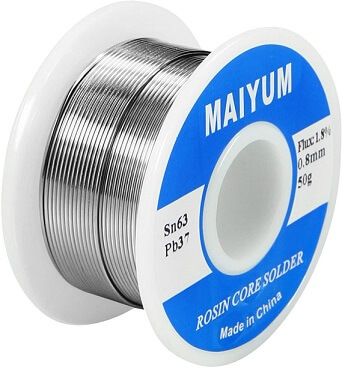
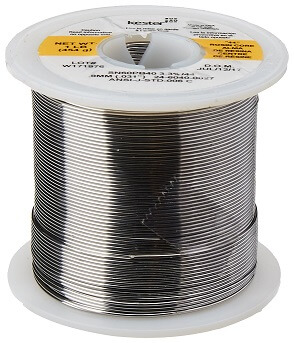
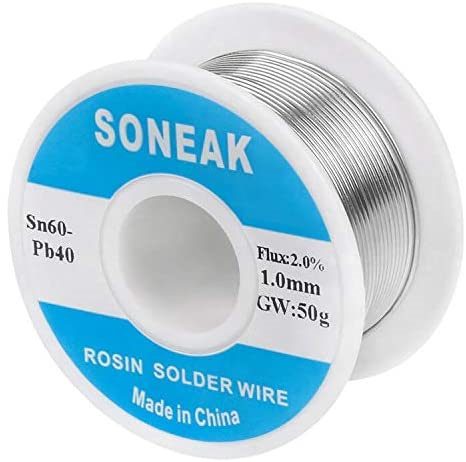
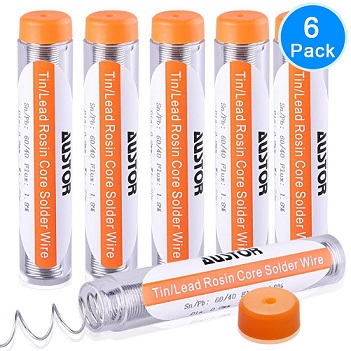
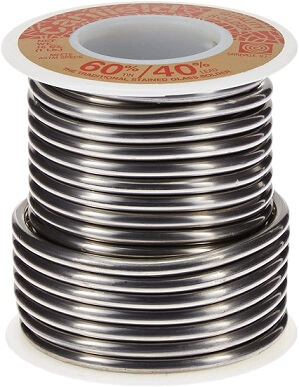
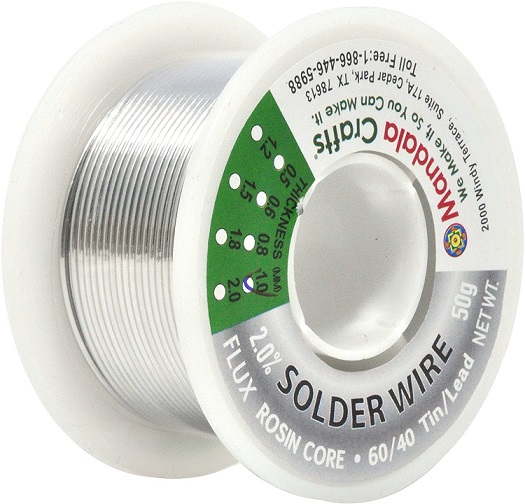

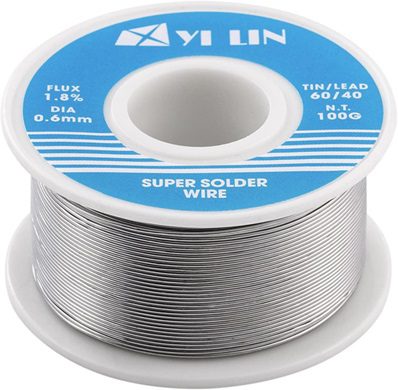



2 Responses
Thank you, this article was just what I was looking for in my search for better soldering joints. I was looking to find what is considered the best type of solder for the DIY I work on. thank you very much. Keep posting items like this. I will be searching for your review on type of soldering irons next. Again thank you very much.
If you do buy Kaina solder, you need to be sure it’s the one with the blue and white label. As the same company makes a solder that is totally useless for electronics.
Buy the thinnest you can get.